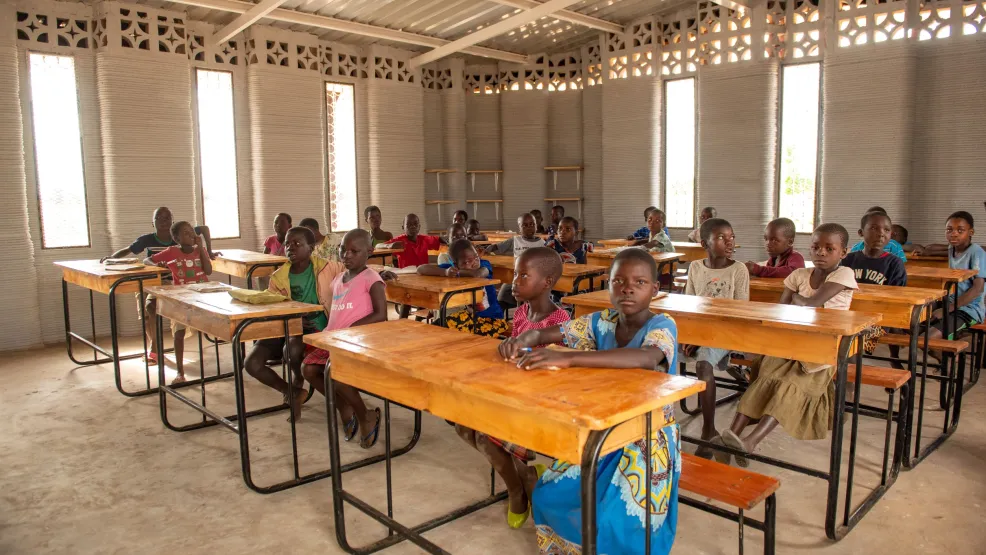The first commercial construction 3D printer made in Africa has been unveiled. Dubbed Iroko, the system was developed by 14Trees, a joint venture between Holcim and the UK’s development finance institution, British International Investment, along with African construction firm Pan Mixers South Africa (PMSA). The first customers in Africa are expected to get their first Iroko units in Q4 2023, with the partners expecting to expand to Europe in Q1 2024.
Iroko boasts many of the benefits of other concrete 3D printers, including a reduced reliance on labor and lower overall material use. Designed for printing one- and two-story buildings, the system can print with Holcim’s TectorPrint material, which the company claims cuts the overall carbon footprint of a building by 70 percent.
Iroko is described as having a price 30 percent less than competitors, with an overall lower cost of use, as well. 14Trees says that it can be mounted manually, without the need for a crane or telehandler, nor is it necessary to have extension units to print a second floor. Built-in laser systems are meant to control print quality. Additionally, a weather station is used to track real-time weather conditions to enable adjustment of printing parameters. It can also fit in a single shipping container, for easier shipment.
Miljan Gutovic, Region Head for Europe at Holcim, said of the product, “I am excited to see 14Trees shaping the future of construction. This innovation will help accelerate construction 3D printing around the world, fully aligned with Holcim’s mission to decarbonize building at scale.”
François Perrot, Managing Director of 14Trees, contributed, “The launch of this Africa-made printer builds on our legacy of 3D printing on the continent, from building the world’s first 3D-printed school in Malawi to the world’s largest 3D-printed affordable housing project in Kenya. I look forward to scaling up this transformational technology even further with Iroko, to decarbonize building in Africa and beyond.”

Africa’s “first” 3D printed building, made by 14Trees.
The development represents a number of important trends occurring in additive manufacturing (AM). While the AM sector in the Middle East has been developing at a rapid pace, the same hasn’t been true of the southern half of Africa. There is significant research taking place and South Africa itself has seen some successful commercialization efforts, but this hasn’t been replicated across the continent as a whole. Therefore, the development of a commercial additive construction system in the region is particularly crucial.
However, this is part of a larger pattern at work. Re-localization is a key macro trend for the next stage in globalization due to the increased energy costs associated with depletion of accessible fossil fuels and the decreased natural resources available. For this reason, every region is develop robust forms of local, digital manufacturing. That this is being demonstrated with additive construction is notable given the significant amount of infrastructure that needs to be built in developing parts of the continent.
Images courtesy of 14Trees.
Subscribe to Our Email Newsletter
Stay up-to-date on all the latest news from the 3D printing industry and receive information and offers from third party vendors.
You May Also Like
New Report: Semiconductor Industry to See $1.4B in 3D Printing Revenues by 2032
“The semiconductor sector has become the most strategically significant area of global industry.” Truer words are hard to come by when it comes to the modern world, and they are...
Will Photonic-Crystal Lasers Revolutionize 3D Printing?
Powder bed fusion (PBF) for metals and polymers predominantly utilizes lasers as the primary heat source. Some directed energy deposition (DED) technologies also employ lasers, while various vat polymerization methods...
3D Printing Unpeeled: Orbex Investment, IndoMIM and HP, Ultrasonic Waves
INDO-MIM has bought three HP Metal Jet S100 printers, operating two in India and one in Texas. This is a win for HP because the company has deep experience in...
3D Printing Webinar and Event Roundup: April 21, 2024
It’s another busy week of webinars and events, starting with Hannover Messe in Germany and continuing with Metalcasting Congress, Chinaplas, TechBlick’s Innovation Festival, and more. Stratasys continues its advanced training...































